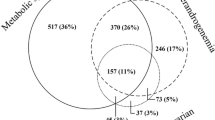Abstract
Background: There is a very high prevalence of obese women in the infertile population and many studies have highlighted the link between obesity and infertility. The aim of this study was to evaluate the prevalence of oligomenorrhea in uncomplicated obesity, and to examine whether this menstrual alteration is associated with anthropometric, hormonal, and metabolic parameters. Patients and methods: This is a cross-sectional study of 266 overweight and obese body mass index (BMI)>-25.0 kg·m-2] women, all having apparent normal fertility. Measurements included BMI, central fat accumulation (evaluated by waist circumference), blood pressure levels, and fasting insulin, glucose, and lipid (triglycerides, total and HDL-cholesterol) serum concentrations, and insulin resistance [estimated by (homeostasis model assessment) HOMAIR] during the early follicular phase (days 2–5 of the menstrual cycle). Results: One hundred and seventy-one (64.3%) of 266 women had normal menstrual cycles, 57 (21.4%) had oligomenorrhea, and 38 (14.3%) had hypermenorrhea and/or polimenorrhea. Women with oligomenorrhea had higher waist circumference, BMI, HOMAIR, and insulin levels than women with normal menstrual cycles. When association among oligomenorrhea and other variables (waist circumference, BMI, insulin and HOMAIR) was evaluated by logistic regression, and odds ratio was calculated per unit of SD increase, only waist circumference maintained a significant relationship with oligomenorrhea. Conclusions: This study shows that more than 20% of women with simple obesity have oligomenorrhea, and suggests that central fat accumulation seems to have a possible direct role in this menstrual alteration, independently of hyperinsulinemia and/or insulin resistance.
Similar content being viewed by others
References
Ramsay JE, Greer I, Sattar N. ABC of obesity. Obesity and reproduction. BMJ 2006, 333: 1159–62.
Grodstein F, Goldman MB, Cramer DW. Body mass index and ovulatory infertility. Epidemiology 1994, 5: 247–50.
Norman RJ, Clark AM. Obesity and reproductive disorders: a review. Reprod Fertil Dev 1998, 10: 55–63.
Mitchell GW, Rogers J. The influence of weight reduction on amenorrhea in obese women. N Engl J Med 1953, 249: 835–7.
Hartz AJ, Barboriak PN, Wong A, Katayama KP, Rimm AA. The association of obesity with infertility and related menstrual abnormalities in women. Int J Obesity 1979, 3: 57–73.
Lake JK, Power C, Cole TJ. Women’s reproductive health: the role of body mass index in early and adult life. Int J Obes Relat Metab Disord 1997, 21: 432–8.
Bolúmar F, Olsen J, Rebagliato M, Sáez-Lloret I, Bisanti L. Body mass index and delayed conception: a European multicenter study on infertility and subfecundity. Am J Epidemiol 2000, 151: 1072–9.
Linnè Y. Effects of obesity on women’s reproduction and complications during pregnancy. Obesity Rev 2004, 5: 137–43
Norman RJ, Noakes M, Wu R, Davies MJ, Moran L, Wang JX. Improving reproductive performance in overweight/obese women with effective weight management. Hum Reprod Update 2004, 10: 267–80.
Teitelman M, Grotegut CA, Williams NN, Lewis JD. The impact of bariatric surgery on menstrual patterns. Obes Surg 2006, 16: 1457–63.
Yoo RY, Dewan A, Basu R, Newfield R, Gottschalk M, Chang RJ. Increased luteinizing hormone pulse frequency in obese oligomenorrheic girls with no evidence of hyperandrogenism. Fertil Steril 2006, 85: 1049–56.
Grenman S, Rönnemaa T, Irjala K, Kaihola HL, Grönroos M. Sex steroid, gonadotropin, cortisol, and prolactin levels in healthy, massively obese women: correlation with abdominal fat cell size and effect of weight reduction. J Clin Endocrin ol Metab 1986, 63: 1257–61.
De Pergola G, Maldera S, Tartagni M, Pannacciulli N, Loverro G, Giorgino R. Inhibitory effect of obesity on gonadotropin, estradiol, and inhibin B levels in fertile women. Obesity (Silver Spring) 2006, 14: 1954–60.
Bonora E, Targher G, Alberiche M, et al. Homeostasis model assessment closely mirrors the glucose clamp technique in the assessment of insulin sensitivity: studies in subjects with various degrees of glucose tolerance and insulin sensitivity. Diabetes Care 2000, 23: 57–63.
Tchernof A, Desmeules A, Richard C, et al. Ovarian hormone status and abdominal visceral adipose tissue metabolism. J Clin Endocrinol Metab 2004, 89: 3425–30.
Taponen S, Martikainen H, Jarvelin MR, et al. Hormonal profile of women with self-reported symptoms of oligomenorrhea and/or hirsutism: Northern Finland Birth Cohort 1966 Study. J Clin Endocrinol Metab 2003, 88: 141–7.
Ovalle F, Azziz R. Insulin resistance, polycystic ovary syndrome, and type 2 diabetes mellitus. Fertil Steril 2002, 77: 1095–105.
Pirwany IR, Yates RWS, Cameron IT, Fleming R. Effect of the insulin sensitizing drug metformin on ovarian function, follicular growth and ovulation rate in obese women with oligomenorrhoea. Hum Reprod 1999, 14: 2963–8.
Solomon CG, Hu FB, Dunaif A, et al. Menstrual cycle irregularity and risk for future cardiovascular disease. J Clin Endocrinol Metab 2002, 87: 2013–7.
Author information
Authors and Affiliations
Corresponding author
Rights and permissions
About this article
Cite this article
De Pergola, G., Tartagni, M., d’Angelo, F. et al. Abdominal fat accumulation, and not insulin resistance, is associated to oligomenorrhea in non-hyperandrogenic overweight/obese women. J Endocrinol Invest 32, 98–101 (2009). https://doi.org/10.1007/BF03345694
Accepted:
Published:
Issue Date:
DOI: https://doi.org/10.1007/BF03345694




